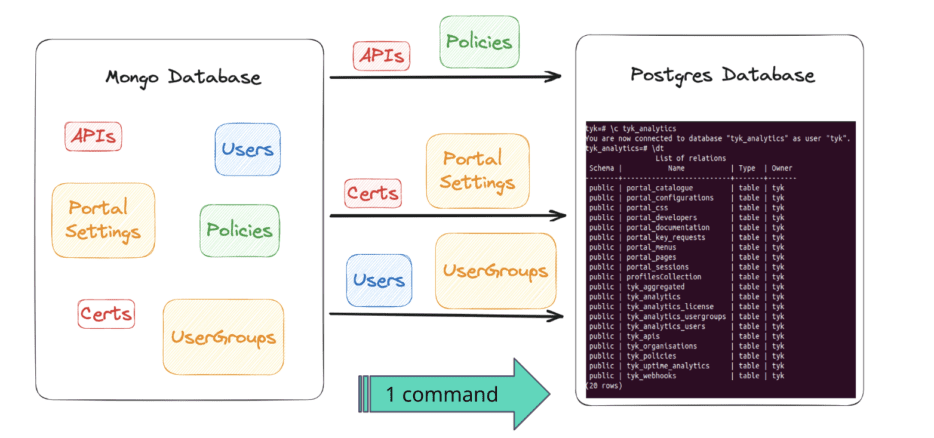As your application grows and evolves, consider migration from MongoDB to PostgreSQL for your data storage needs. If most of your applications have started using PostgreSQL, and you use Tyk as your API gateway, you’re in luck! Tyk has introduced a migration tool from version 4.0 onwards that simplifies migrating your data from MongoDB to PostgreSQL.
In this blog post, we will explore the benefits of migrating to PostgreSQL, discuss Tyk’s migration tool, and guide you through the process.
The advantages of transitioning to PostgreSQL
While the decision to migrate from MongoDB to PostgreSQL depends on your specific use case and requirements, it’s worth considering the advantages that PostgreSQL brings to the table.
When it comes to choosing a database for your application, PostgreSQL (Postgres) emerges as a robust and feature-rich option. We will explore three reasons PostgreSQL might be the ideal choice for your project. From built-in password complexity options to performance advantages, PostgreSQL also offers specific benefits that can enhance the security and efficiency of your application.
Enhanced password complexity
One notable strength of PostgreSQL is its built-in password complexity options. By default, Postgres provides mechanisms to enforce strong password policies. You can define password length requirements to implement the inclusion of uppercase and lowercase letters, digits, and special characters. This native support for password complexity ensures that user credentials are adequately protected, mitigating the risk of unauthorised access due to weak passwords.
Performance advantages with TOAST
The TOAST (The Oversized-Attribute Storage Technique) feature allows PostgreSQL to efficiently handle large or out-of-line values. TOAST transparently stores such data separately from the main table, enabling faster loading and retrieval times. PostgreSQL’s TOAST feature gives it an advantage in handling and processing data more effectively.
SQL features for advanced queries
PostgreSQL enables the creation of custom functions using SQL, PL/pgSQL, or other supported programming languages such as Python or JavaScript. This flexibility allows developers to encapsulate complex business logic into reusable functions, making queries more concise when running repetitive tasks. Take a look at extensions such as pg_cron – creating and utilising custom functions empowers developers to tailor PostgreSQL to their application’s unique needs.
Tyk’s migration tool
Tyk has introduced a migration command from Version 4.0 onwards to facilitate the migration process. This migration tool helps you seamlessly transfer your data from MongoDB to PostgreSQL, including the following components:
Migration process
To migrate your data from MongoDB to PostgreSQL using Tyk’s migration tool, follow these steps:
Step 1: Prepare your PostgreSQL database: Set up a PostgreSQL instance and ensure it is compatible with one of the supported versions (11.x, 12.x, 13.x, 14.x, or 15.x).
Step 2: Backup your MongoDB data: Before proceeding with the migration, create a backup of your MongoDB data to ensure you have a fallback option in case of unforeseen issues.
Step 3: Upgrade to Tyk 4.0 or later: Ensure you are running Tyk 4 LTS or 5 LTS versions, as the migration tool is introduced in these versions.
Step 4: Run the migration command: Utilise Tyk’s migration command to initiate the migration process. This command will transfer the specified data components from MongoDB to PostgreSQL.
./tyk-analytics migrate-sql
Step 5: Verify the migration: After the migration process is completed, perform thorough testing and verification to ensure the integrity and correctness of the migrated data.
Note: It’s essential to know that Tyk’s migration tool does not migrate Logs, Analytics, or Uptime analytics data.
A new avenue for data management and optimisation
Migrating from MongoDB to PostgreSQL offers Tyk users many benefits, empowering them to manage their data more effectively, ensure transactional integrity, perform advanced querying and analytics, leverage a rich ecosystem of tools, and achieve scalability and performance. However, it’s important to note that migration should be approached with careful consideration, thorough planning, and proper testing to ensure a smooth transition.
As Tyk users evaluate their application requirements, data models, and long-term goals, migrating from MongoDB to PostgreSQL opens up new data management and optimisation avenues. By harnessing the power of PostgreSQL, Tyk users can elevate their applications to new heights, unlocking enhanced data structure, improved querying capabilities, and a robust ecosystem of tools and support.
Do take a look at our knowledge based articles for more information, or if you’re keen to try it out, feel free to connect with me, and I can share with you more!
